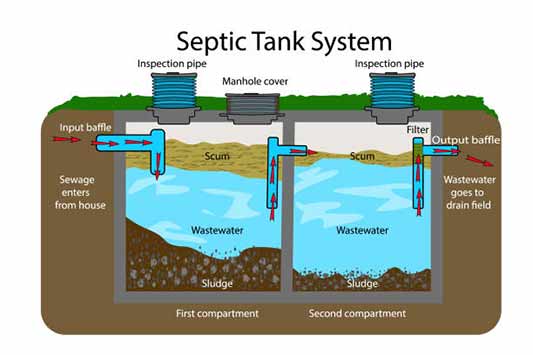
Septic systems are very sensitive to changes in their operating environment. Minor increases in the volume of water flowing from your home into the system or changes in the amount of groundwater can trigger outsized reactions in your septic system, says Mabry Management team.
This is why it is important to understand the intimate relationship between your septic system and the way you use the plumbing facilities in your home. It is also vital to realize the interconnectedness between your septic system and its immediate environment.
As part of the process of gaining this insight, you need proper knowledge of the signs of septic system malfunction in your home. The goal here is to be able to identify and solve problems in the septic system before they become costly emergencies in your home.
Signs of septic system malfunction
The drains in your home are slow
This happens when the pipe leading from your home to the tank is clogged. There are many reasons why the inlet pipe may become clogged. It could be due to buildup within the line itself or because the septic tank is full and overflowing. It could also be that the pipe has been crushed by the weight of vehicles or animal traffic. It is also possible that tree roots have blocked the line. A clogged drain line can be unclogged by snaking it. You can prevent future clogs by flushing only toilet paper and human waste into your toilet and also having the septic system inspected once a year.
Sewage is backing into the home
If the outlet baffle or effluent filter is clogged, it can cause sewage to flow backwards through the inlet pipe and into your home. The first sign of this problem is usually an overflowing toilet. There is a chance that this problem is not due to a clog in your septic tank system. The septic system may be simply reacting because it has received too much water at once. To fix the problem, the effluent filter must be cleaned or replaced; this often requires you to pump the tank. If the problem is that too much water is entering the system, the best course of action is to change your home’s water usage pattern.
Sewage odors near your home
Sewage odors mean your drain field has failed or is saturated with water. A failed drain field can also cause sewage to back up into your home; effluents will flow backward into the house because they have nowhere else to go. Typically, these odors will be strongest above or near the drain field. Bad odors from your septic system can also signify that your drain field has reached the end of its life. Maybe the system has been in use for a long time and has lost the capacity to accept more waste. Or it could just be that the drain field is saturated. A service professional can assess the drain field to know if it can be dried out and rehabilitated.
Isolated patches of bright green or spongy grass
There should be uniform grass growth on or around your drain field. If you have isolated patches of green grass, it is a sign that wastewater is leaking into the surrounding soil. The extra nutrients in this water are the reason for the extraordinary grass growth in this part of your field.
Standing water near the septic tank
When it rains, it is normal for water to pool around your septic tank or on the drain field. But this water should infiltrate into the soil after a short time. If foul-smelling water appears near your drain field and does not dry up after a while, your septic tank could be leaking improperly treated wastewater into the soil. Sometimes, instead of stagnant water around the septic tank, you will find soft soil that bounces under your feet. This is also a sign that your septic tank is leaking.

How to prevent septic system malfunction
To prevent the discussed issues, follow these steps:
Watch what you flush
Only toilet paper, human waste, and water should go into the toilet. Do not dispose of fats, grease, oil, medications, feminine hygiene products, etc. in the septic tank.
Use water efficiently
Install high-efficiency fixtures – faucets, toilets, and showerheads – that minimize water usage. If possible, avoid using your dishwasher, toilet, and shower at the same time. You may also want to avoid doing multiple loads of laundry on the same day.
Inspect and pump annually
Yearly inspections help identify budding septic tank malfunctions before they actually happen. To avoid clogging and also keep solids from migrating into the drain field, the septic tank should be pumped out every 3-5 years.
Lastly, find a qualified septic service provider in your area. The professional you choose should offer septic system inspections and septic tank pumping, as well as repair. They should have a well-established reputation with lots of local experience.

